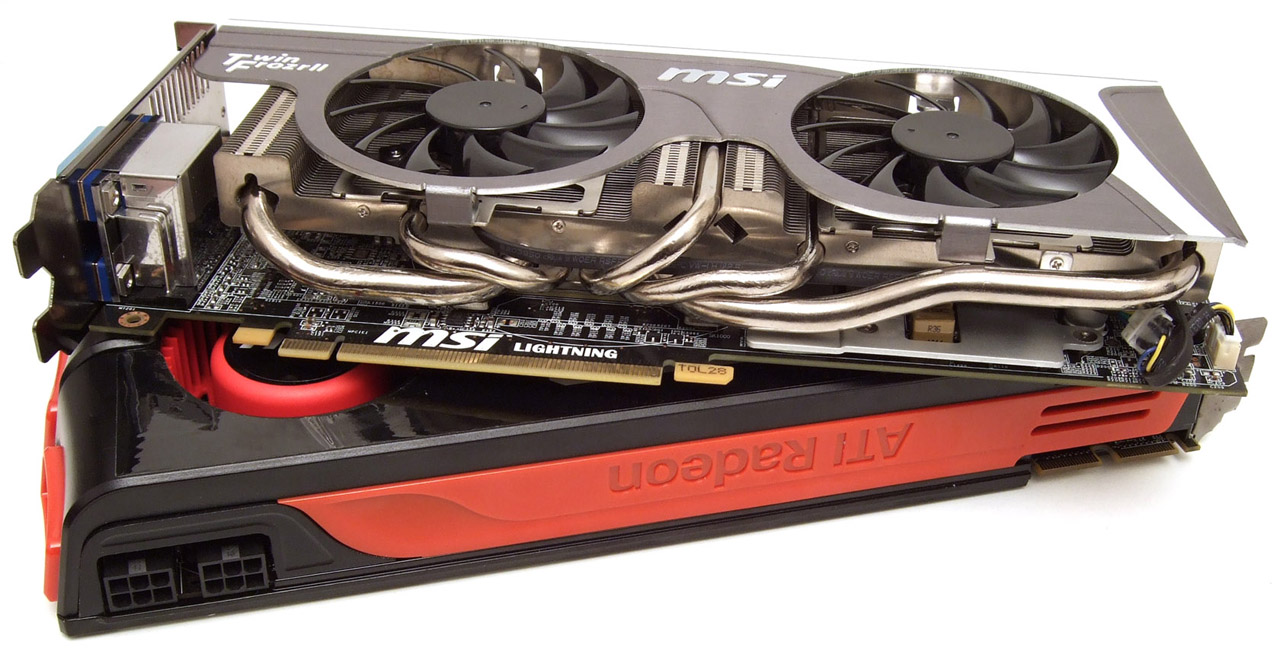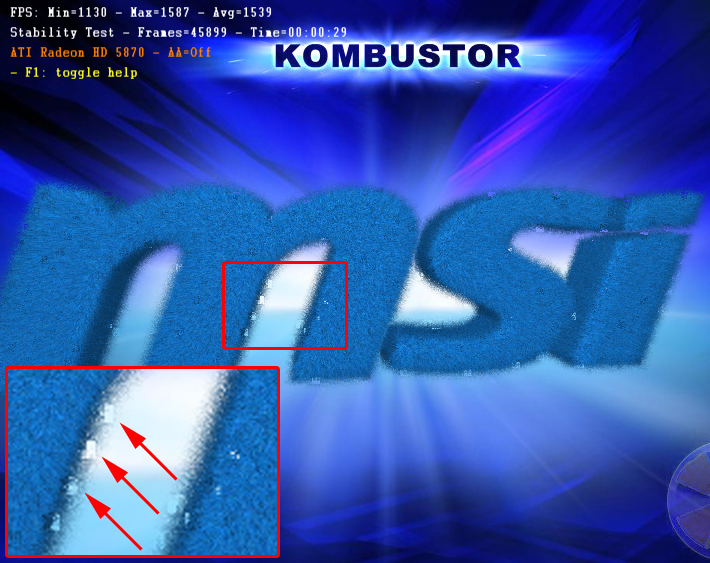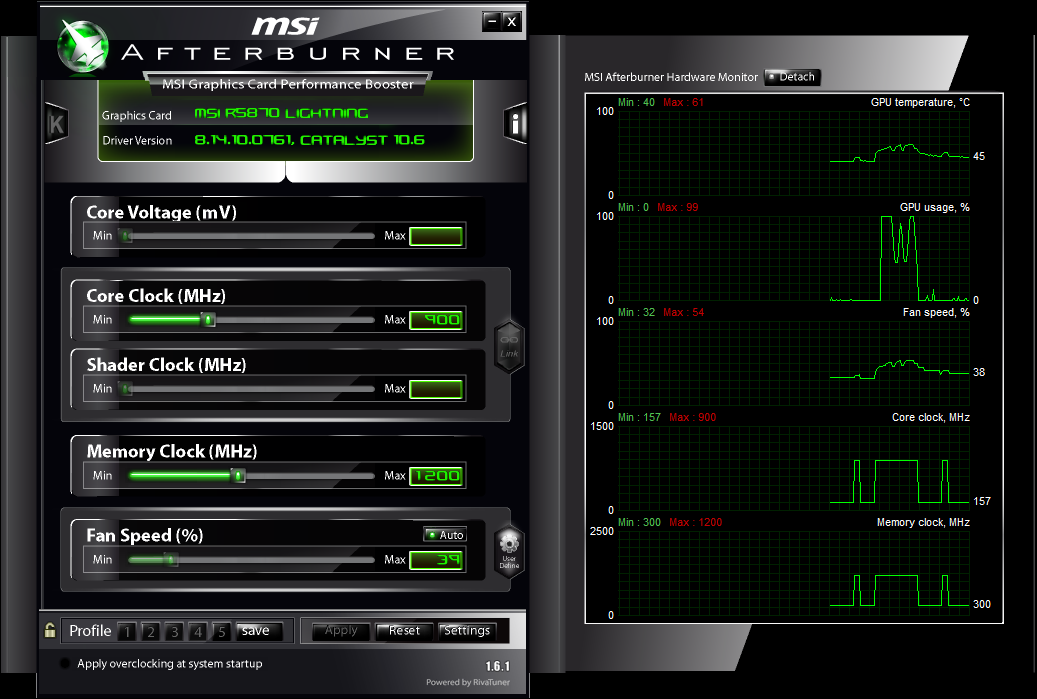Comparison: Factory-Overclocked Versus Reference Graphics
In order to set their products apart, third-party vendors take reference GPUs from AMD and Nvidia, then make their own tweaks to layout, cooling, and performance. We're comparing a tuned-up card from MSI to AMD's reference Radeon HD 5870 to measure value.
Differences: Reference Versus Aftermarket
The Radeon HD 5870 is currently AMD's most powerful single-GPU graphics solution. It is 11+ inches (28 cm) long, requires two physical expansion slots, and covered by a plastic shroud that also serves as an air duct. A radial fan on one end of the card pushes air across the GPU cooler, and the heated air leaves the system through the opening vents at the card’s slot cover. This cooling concept works pretty well, as it not only provides effective graphics component cooling, but it also helps to remove warm air from the inside of your PC. Entry-level graphics solutions can be cooled at very low noise, while high RPM speeds of the radial fan help to keep high-end graphics solutions cool.
MSI’s Lightning version is slightly shorter at 26 cm, but it still requires two slots for installation. The first key difference relates to power, as MSI requires two 8-pin PCIe connectors instead of two 6-pin auxiliary power connectors on the reference board. However, the package includes the necessary adapters in case your power supply doesn't include two 8-pin outputs.
The second key difference is the cooling solution, which employs five heat pipes and two 75 mm fans. Heat pipes are best if you want to distribute heat across a larger surface. The dual fans are able to run at a slower rotation speed than AMD's blower, providing a more distributed air flow across the card and less total noise. The disadvantage is the absence of a cooling duct, which may be an issue especially now, in the summer, because the two fans essentially blow hot air around in your case without getting rid of it. Thus, it is important to ensure adequate system ventilation using additional fans.
AMD's reference Radeon HD 5870 clock speed is 850 MHz, while the video memory runs at 1,200 MHz. In general, vendors seem to take one of two different approaches to overclocking. Factory-overclocked cards either come with slightly increased GPU speeds and an overclocking tool to try your luck at squeezing out more frequency (at your own risk). Or, there are aggressively-overclocked models (GPU) with slight memory clock optimizations as well.
In everyday operation, it makes only limited sense to overclock the graphics chip alone. Therefore it is important to use tools that allow checking the impact of overclocking settings in real 3D workloads. MSI’s Kombustor is one possible tool. We found that, using this tool, you have to restart your system once aggressive settings result in a corrupted image (see screenshot above), even if you turn clocks back down.
MSI’s R5870 Lightning runs factory-overclocked, but leaves serious overclocking to the customer: the GPU runs at 900 MHz (a mere 50 MHz increase) and the memory at 1,200 MHz, the same as AMD's reference design.
The center of the MSI overclocking world, as interpreted by MSI, is the Afterburner tool. It effectively replaces Riva Tuner and works with most graphics cards models. We like that it’s very functional and easy to use. Effectively, we’d compare it to EVGA's Precision tool for Nvidia. Afterburner is equivalent, but it can serve AMD and Nvidia graphics products. The current version (1.61) requires AMD's Catalyst driver and is actually based on Riva Tuner;'s features. Since the tool is so easy to use, we ended up using it for all our overclocking testing.
Get Tom's Hardware's best news and in-depth reviews, straight to your inbox.
Current page: Differences: Reference Versus Aftermarket
Prev Page Graphics Cards And Configurations Compared Next Page 2D Temperature, Noise, Power Consumption-
rohitbaran Too less performance gain (4-5 FPS) for the too much extra price paid ($50-$70) along with too much increase in power consumption (30-40 W. Better to buy a reference card unless you want the best no matter what the price is.Reply -
Mark Heath I like the idea behind the article and I'm glad that there's been some testing done on it, but I don't really like the article itself.Reply
There are references to how much the reference card is overclocked by, but there is no clear section about it, you started off with some of the summary charts, instead of putting them after the initial tests and you kept switching what cards you were comparing, with less warning than I would like..
Plus there's that 2GB 5850. Is that really a 2GB 5850, or is it actually 2GB 5830, because it kept getting beaten by the 1GB 5850..
-
Onus When I buy a new GPU, I look for one who's reference clocks make it "good enough" as-is; but I do look for a better / quieter cooler.Reply -
mrhoshos96 great article but u should have compared the reference against the sapphire vapor-xReply -
Tesla1483 ReplyIn order to their products apart, third-party vendors take reference GPUs...
I'm guessing they meant "In order to SET their products apart..."
Seriously, it's the first sentence in the article. Does no one proof read anything here? Isn't that like the first thing you learn when you want to become a writer? Sorry, rant over. -
youssef 2010 "This cooling concept works pretty well, as it not only provides effective graphics component cooling, but it also helps to remove warm air from the inside of your PC. "Reply
The reference 5870 has a vent on its side so, it doesn't completely remove the hot air from the case but recirculates a part of the hot air back into the case -
duk3 It's a 5850, look how close the framerates are.Reply
The amount of ram doesn't really matter at these resolutions. -
LLJones The cards just do not offer enough gain. If you can afford the overclock edition at a premium, then save up a little more and get the next card up or buy two of the next lower cards. The $1000+ dual 5870 from Asus shows what a complete waste of money some, not all, super OC cards are.Reply
Try this, put together a really really really premium card component wise, and then don't put any cooling on it. Let me decide what I am going to do for cooling and companies can save on packaging, shipping etc due to no cooler.
If your really aiming at the OC crowd and not just playing a game of marketing, then you know the first thing someone does is to rip off your factory cooler to replace it or at the very least put quality thermal compound on it.


